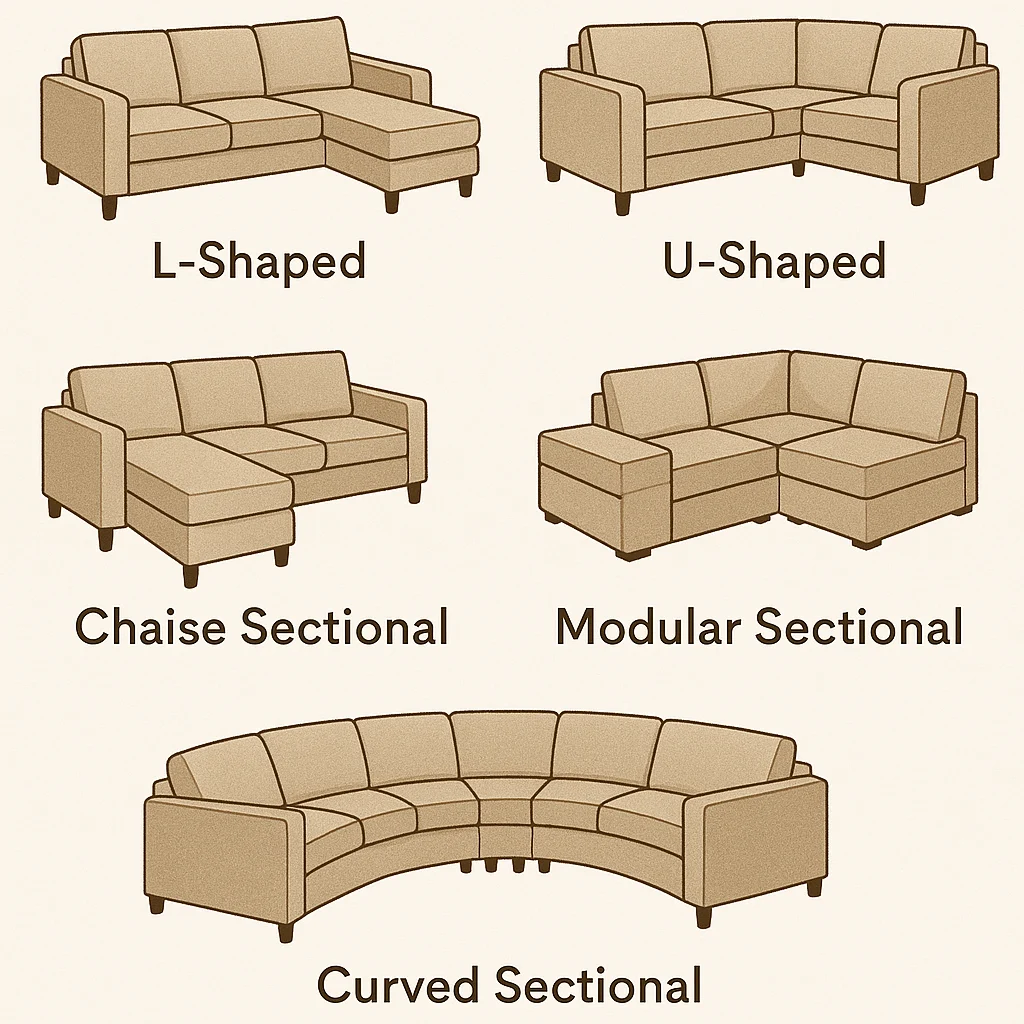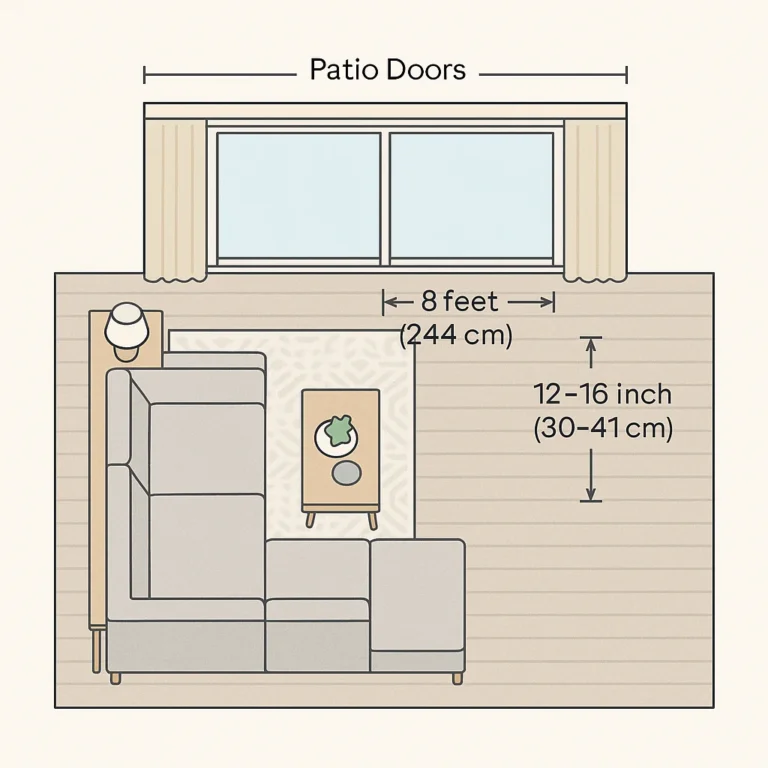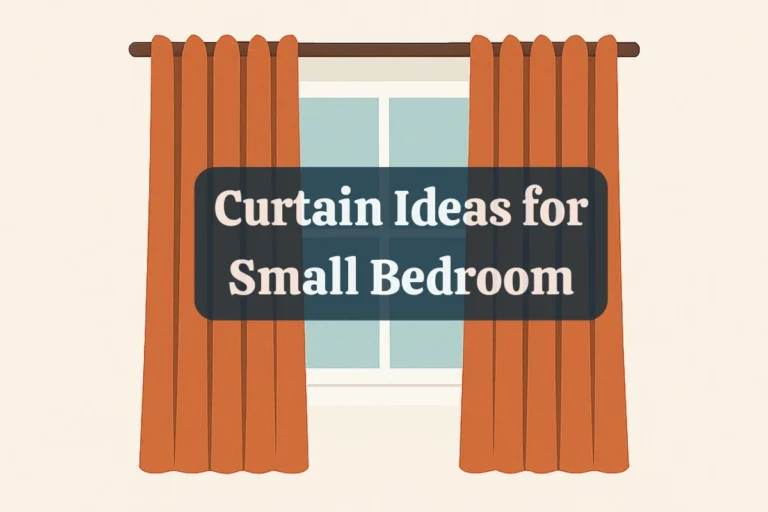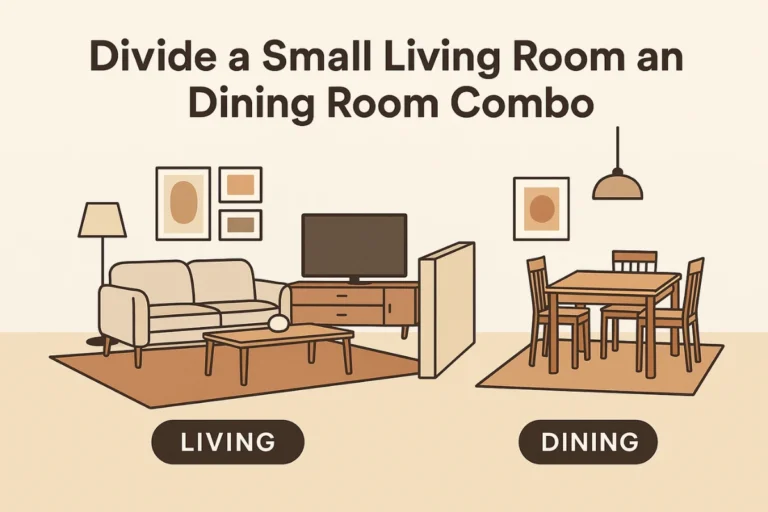How to Arrange the Top 5 Sectionals in a Small Living Room
When space is limited, the right sectional can be a game-changer—or a space-hog. In this guide, we’ll break down the top 5 sectional types and show you exactly how to make each one work in a compact room.
1. L‑Shaped Sectional
An L-shaped sectional is a top performer in compact living rooms. It turns an overlooked corner into functional seating and carves out a cozy conversation zone, without blocking walkways or crowding the room’s center.
Most models now feature reversible chaises, so you can flip the short side to fit your space. That flexibility makes it perfect for renters, evolving floor plans, or rooms with tricky architecture.
Best Placement Strategies for L-Shaped Sectionals
✔️ Corner-Hugging Layout
Tuck the L-shape into the far corner of the room. This opens up the middle of the space and makes the seating area feel grounded and cozy. It works especially well in square or rectangular rooms that don’t have a built-in focal point.
✔️ Floating the Sectional
In open-plan spaces, try floating the sectional with its back toward the kitchen or entry. This helps define the living area without using extra dividers like bookshelves or screens.
✔️ Chaise or Short Side by the Window
If your sectional has a chaise or shorter side, place it near a window. This lets the longer side face into the room and keeps natural light flowing through the space.
✔️ If Facing a TV
Sometimes only one side of the L-shape faces the TV. In that case, mount the TV on a swivel arm so it can turn toward both sides for a better view.
Styling Features That Work
- Anchor with a rug: Choose a 5′×8′ or 6′×9′ rug that extends 6–12 inches beyond the sectional.
- Add vertical interest: Place a tall floor lamp or plant in the inside “L” corner to draw the eye up.
- Pick a lean silhouette: Look for low backs, slim arms, and raised legs to keep things airy.
- Keep tables slim: Use a narrow rectangular or oval coffee table and leave 16–18″ of walking room.
Real-Life Room Example
- Room Size: 10′ × 12′ rectangular
- Sectional: 78″ × 58″ with reversible chaise
- Setup: Sectional is tucked into the far corner with a 6′×9′ rug. A wall-mounted TV faces the couch, and a narrow floor lamp fills the back corner.
Outcome: A grounded, focused seating area with 30–36″ clearances and a cozy, open feel.
2. U‑Shaped Sectional
A U-shaped sectional offers wraparound comfort—perfect for lounging, hosting, or movie nights. Though it has a larger footprint than an L-shape, you can make it work in a small space by scaling down and using it to subtly divide zones.
The key is choosing a compact version or modifying the placement so it doesn’t cut off circulation or dominate the floor.
Best Placement Strategies for U-Shaped Sectionals
✔️ Use One Side as a Wall Anchor
Push one short arm of the U against a wall to save space and keep the layout feeling open. This still gives you the cozy, wraparound feel of a U-shaped sofa while freeing up the rest of the room for walking space or other furniture.
✔️ Open One End
If a full U-shape feels too heavy, swap one arm for an ottoman or an armless chair. This “U-lite” setup feels more open and makes it easier to move around—great for tighter layouts or rooms with lots of traffic.
✔️ Float the Sectional
In an open-concept space or studio apartment, let the back of the sectional float between zones—like between the living area and dining space. It helps create a clear separation without needing walls or extra furniture.
✔️ Face a Focal Point
No matter where you put it, try to point the open part of the U toward a focal spot, like a TV, fireplace, or big window. This gives the layout purpose and helps the room feel more pulled together.
Styling Features That Work
- Use a soft ottoman or nesting tables to avoid blocking foot traffic inside the U.
- Lean into symmetry with paired art, plants, or lamps on either side.
- Keep it light with narrow arms, low backs, and open bases.
- Leave space to breathe—12–18″ from walls or other furniture works best.
Real-Life Room Example
- Room Size: 11′ × 13′ open-plan
- Sectional: 96″ wide U-shape; each arm ~32″ deep
- Setup: One side along the back wall, one side floating into the room to divide it from the dining area. A round ottoman softens the middle.
Outcome: A comfortable nook with flow around all sides—perfect for guests, conversation, or a chill movie night.

3. Chaise Sectional (Sofa + Chaise)
The chaise sectional is one of the most versatile shapes for small living rooms. It offers the full comfort of a sectional—thanks to the extended chaise—without the visual or physical bulk of larger L- or U-shapes.
Its compact footprint and single-armed design make it ideal for narrow rooms, studio apartments, and multifunctional spaces. Bonus: Many chaise sectionals are reversible, giving you flexibility if your layout or needs change.
Best Placement Strategies for Chaise Sectionals
✔️ Place the Chaise on the Low-Traffic Side
If your room has a main walkway—like between a doorway and kitchen—place the chaise on the opposite side. This keeps pathways clear and helps the room feel more open and easy to move through.
✔️ Use the Chaise to Frame a Window or View
Point the chaise toward a window, TV, or focal wall. This draws the eye outward, which helps stretch the room visually and creates a nice sense of direction in tighter spaces.
✔️ Float the Sofa Side
If your layout doesn’t have much usable wall space, try floating the back of the sofa into the room and letting the chaise angle off to one side. It gives you a cozy lounge zone without blocking walkways.
✔️ Test Orientation with a Reversible Chaise
If your sectional has a reversible or “flip-flop” chaise, try both directions before settling on a final layout. It’s an easy way to see what works best for your traffic flow and lighting.
Styling Features That Work
- Balance the chaise with a tall plant, shelf, or wall sconce on the opposite end.
- Use compact coffee tables or nesting tables that tuck neatly beside the seat.
- Frame the zone with verticals like curtains, floor lamps, or art.
- Define it with a rug that extends at least 6″ beyond the edges.
Real-Life Room Example
- Room Size: 10′ × 11′
- Sectional: 82″ sofa with a 60″ chaise
- Setup: Chaise runs along the window wall, sofa side floats into the room. Wall-mounted light and shelf balance the layout; slim coffee table and rug center the scene.
Outcome: An inviting, airy lounge setup that’s functional without blocking movement.
4. Modular Sectional
Modular sectionals are made up of individual pieces—like armless chairs, corner units, ottomans, and chaises—that can be rearranged into almost any shape. That makes them ideal for small spaces that may evolve (think: studio apartment by day, movie lounge by night).
What makes modular sectionals different is their built-in adaptability. You’re not locked into an L-shape or U-shape—you can float pieces, split them into a sofa and chair combo, or change your layout entirely as needs shift.
Best Placement Strategies for Modular Sectionals
✔️ Build a Compact L-Shape
Start by combining a corner piece with two armless chairs to make an L-shape. It fits neatly into a corner and opens up the rest of the room. Later on, you can add or move pieces if your layout changes—great for flexibility.
✔️ Separate and Float the Pieces
Don’t feel like you have to keep everything together. You can break up the sectional into smaller parts—like a sofa on one side and a single seat near a window. This works especially well if your room has multiple doors or a tricky layout.
✔️ Use an Ottoman as a Soft Divider
Instead of a coffee table, use a square or rectangular ottoman in the middle. It helps define the space without adding bulk, and it’s even better if it has hidden storage inside.
✔️ Keep the Back Light
Some modular sectionals have removable back cushions. If you need the room to feel more open—like when guests come over—just take off a few cushions to make the layout feel lighter and more spacious.
Styling Features That Work
- Stick to slim frames and open bases to reduce visual heaviness.
- Tie it together with a rug—helps unify even scattered arrangements.
- Use a consistent color scheme for cohesion, even if the pieces move around.
- Add vertical accents like lamps, shelves, or a gallery wall for structure.
Real-Life Room Example
- Room Size: 9′ × 12′
- Sectional: 4-piece set (corner + 2 armless chairs + ottoman)
- Setup: Compact L-shape anchors two walls. One armless seat floats under a window. Rug and ottoman unify the space.
Outcome: A flexible setup that supports lounging, reading, guests, or movie nights, without crowding the space.
5. Curved Sectional
A curved sectional offers softer lines, visual flow, and organic movement—a welcome contrast to the boxy shapes in most small rooms. While it’s not the go-to shape for tight quarters, a well-scaled curved sectional can bring a luxe, airy feel when floated or styled thoughtfully.
It works best when it’s allowed to breathe, which means resisting the urge to push it flush against a wall. In square rooms, studio apartments, or open floor plans, this shape can make the space feel bigger, not smaller.
Best Placement Strategies for Curved Sectionals
✔️ Float It in the Center (Even in Small Rooms)
Instead of pushing the curved sectional against a wall, where it rarely fits well, let it float in the middle of the room. This works great in square rooms or open layouts where the furniture helps define the space.
✔️ Pair It with Rounded Furniture
Match the curve with a round or oval coffee table. It keeps the layout flowing and avoids the awkward clash of sharp corners against soft lines.
✔️ Keep the Perimeter Clear
Give the sectional a little room to breathe—aim for 8 to 12 inches of space around the edges. This helps it stand out without making the room feel crowded.
✔️ Face It Toward the Focal Point
Make sure the open side of the curve looks toward something worth focusing on—like a fireplace, window, or TV. If your TV is off to the side, a swivel mount helps make it work with the shape.
Styling Features That Work
- Avoid wall-hugging—float it to highlight the shape.
- Stick with low backs and wide curves to reduce visual weight.
- Use centered lighting (like a pendant or arc lamp) to anchor the space.
- Keep accessories minimal so the sectional can shine.
Real-Life Room Example
- Room Size: 11′ × 11′ square
- Sectional: 96″ shallow arc (4-seater)
- Setup: Floated in the center over a round rug, with a pedestal table and pendant light. A wall-mounted TV faces the curve.
Outcome: Open, sculptural, and clean. The gentle curve softens the room and makes it feel larger.
| # | Sectional Type | Shape | Small‑Room Pros | Key Tip |
|---|---|---|---|---|
| 1 | L‑Shaped | L | Corner-friendly, versatile | Choose reversible chaise |
| 2 | U‑Shaped | U | Conversation-zone, can scale down | Use U-lite versions |
| 3 | Chaise | Sofa+Chaise | Streamlined, flexible footprint | Reversible option helps |
| 4 | Modular | Pieces | Extremely adaptable & mobile | Ideal for evolving needs |
| 5 | Curved | Arc | Stylish focal point, cozy flow | Float centrally, pair with round rug |
✔️ Quick Takeaways:
- Most Flexible: Modular and Chaise sectionals
- Best for Tight Corners: L-Shaped
- Best for Hosting: Compact U-Shaped
- Most Visually Striking: Curved
- Best for Open Flow: Chaise and Curved






